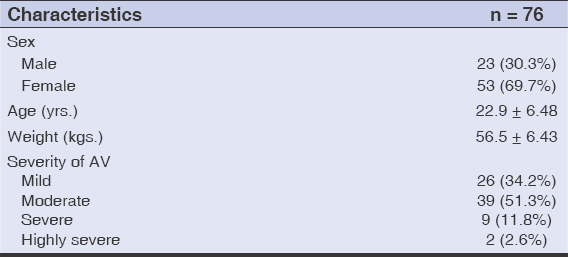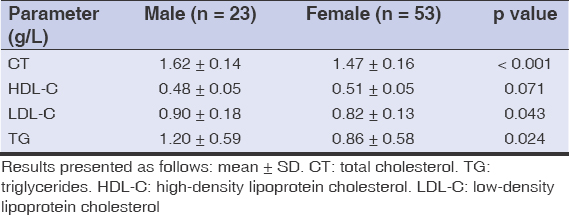Serum lipide profile and the severity of acne vulgaris at a Moroccan referral hospital
Hasna Kerrouch , El Khalil El Bakali, Rachid Frikh, Naoufal Hjira, Mohammed Boui
, El Khalil El Bakali, Rachid Frikh, Naoufal Hjira, Mohammed Boui
Department of Dermatology Venerology, Military Hospital Instruction Mohammed V, University Mohammed V, Rabat, Morocco
Corresponding author: Hasna Kerrouch, MD
Submission: 02.02.2022; Acceptance: 04.05.2022
DOI: 10.7241/ourd.20223.21
Cite this article: Kerrouch H, El Bakali EK, Frikh R, Hjira N, Boui M. Serum lipide profi le and the severity of acne vulgaris at a Moroccan referral hospital. Our Dermatol Online. 2022;13(3):317-318.
Citation tools:
Copyright information
© Our Dermatology Online 2022. No commercial re-use. See rights and permissions. Published by Our Dermatology Online.
Sir,
Acne vulgaris (AV) is one of the most frequent concerns in dermatology consultation. It is an inflammatory chronic condition that affects the pilosebaceous follicle.
Based on the number and types of lesions, AV is classified as mild, moderate, severe, and highly severe [1]. The pathogenesis of AV is due to multiple factors, such as sebum overproduction, inflammation, colonization by Propionibacterium acnes, hyperkeratinization, the genetic component, and stress [2–4]. It is known that the sebaceous glands produce and secret sebum, which is a combination of complex lipids, such as squalene, triglycerides, wax, and cholesterol, as well as free cholesterol and fatty acids [5]. A number of studies evaluated the relationship between acne vulgaris and the serum lipid profile.
Therefore, the aim of our study was to analyze the lipid serum profile among Moroccan patients with acne.
We prospectively conducted a study between June 2020 and December 2021 at the Mohammed V Military Hospital in Rabat, Morocco.
The criteria for inclusion in the study were AV patients aged from thirteen to thirty years. The exclusion criteria were obesity, pregnancy and lactation, oral contraceptives, hormonal therapy, cardiovascular disease, and health conditions affecting lipid metabolism.
The clinical data collected from patients included age, sex, weight, and the severity of AV. Acne grading was performed by the same dermatologist according to the Global Acne Grading System (GAGS). The patients were required to have been fasting between eight to twelve hours at the time of the blood test.
Statistical analysis was performed with JAMOVI. The results were presented as follows: mean ± SD.
Descriptive statistics were performed; Student’s t-test, ANOVA, and X2 were used as statistical tests to compare between variables, and p < 0.05 was considered a statistically significant difference.
A total of seventy-six patients were enrolled. The average age was 22.9 ± 6.48 years. Among the seventy-six cases, 69.7% were females and 30.3% were males, with a female-to-male ratio of 2.3. Their weight was 56.5 ± 6.43 kg (Table 1).
 |
Table 1: Characteristics of the patients (n = 76) |
In our study, most of the patients had moderate AV (51.3%), followed by mild (34.2%), severe (11.8%), and highly severe AV (2.6%).
CT was low in 30 patients (39.5%) and normal in 46 patients (60.5%). TG was low in 38 patients (50%), normal in 23 patients (30.3%), and high in 15 patients (19.7%).
HDL-C was low in 8 patients (10.5%) and normal in 68 patients (89.5%). LDL-C was normal in 76 patients (100%).
There was a statistically significant difference in the mean values of plasma CT, HDL-C, LDL-C, TG, and the severity of AV (p < 0.001) (Table 2).
 |
Table 2: Serum lipid profile of the patients with different grades of acne |
There was a statistically significant difference in the mean values of plasma CT, TG, and LDL-C between the males and females (p < 0.05), yet there was no such statistically significant difference in the mean value of HDL-C (p = 0.071) (Table 3).
 |
Table 3: Serum lipid profile of the male and female patients with acne |
AV is a chronic inflammatory disease that affects the pilosebaceous units. Follicular hyperkeratinization, excess sebum, inflammation, and Cutibacterium acnes are still the four major pathogenic factors [2–4].
Several factors influenced the plasma lipid profiles, such as nutritional status, diet, genetic factors, smoking, and environmental factors [6,7].
In the present study, there was a significant association between CT, HDL-C, LDL-C, TG, and the severity of acne, which was not similar to results reported by previous studies [8]. It might be explained by the high-fat and high-carbohydrate dietary habits in our country.
The role of medications in reducing sebum excretion is essential in the treatment of AV, especially with retinoids. However, their use is limited due to the side effects. Therefore, more studies on medications or substances that may reduce sebum production in AV are needed.
Further studies are needed to observe the relationship between the lipid profile and the severity of AV.
Statement of Human and Animal Rights
All the procedures followed were in accordance with the ethical standards of the responsible committee on human experimentation (institutional and national) and with the 2008 revision of the Declaration of Helsinki of 1975.
Statement of Informed Consent
Informed consent for participation in this study was obtained from all patients.
REFERENCES
1. Akdogan N, Dogan S, Atakan N, Yalçin B. Association of serum hormone levels with acne vulgaris:Low estradiol level can be a pathogenetic factor in female acne. Our Dermatol Online. 2018;9:249-56.
2. Topal IO, Otunctemur A. An investigation of the effects of acitretin on erectile function. Our Dermatol Online. 2020;11(Supp. 3):1-5.
3. Neerja Puri, Bharat Bhushan Mahajan, Samarjeet Kaur Sandhu:Clinical evaluation of different therapeutic modalities in psoriasis by Pasi score. Our Dermatol Online. 2013;4:16-22.
4. Colonna L, Pacifico V, Lello S, Sorge R, Raskovic D, Primavera G. Skin improvement with two different oestroprogestins in patients affected by acne and polycystic ovary syndrome:Clinical and instrumental evaluation. J Eur Acad Dermatol Venereol. 2012;26:1364–71.
5. Ottaviani M, Camera E, Picardo M. Lipid mediators in acne. Mediators Inflamm. 2010;2010:858176.
6. Gonçalves S. Elaboration and subsequent application of a protocol for measuring reduction in a patient with Hashimoto thyroiditis. Our Dermatol Online. 2020;11:243-6.
7. Brzezinski P, Martini L. Sexual abstinence and restraint in Man allow a harmonic wound healing, owing to blood cortisol increment. Our Dermatol Online. 2019;10:e7.1-e7.5.
8. Abdul-Aziz A, Nayaf MS, Mauloodd KJ. The relationship of body mass index and hirsutism in adult females. Our Dermatol Online. 2015;6:276-9.
Notes
Source of Support: Nil,
Conflict of Interest: None declared.
Request permissions
If you wish to reuse any or all of this article please use the e-mail (brzezoo77@yahoo.com) to contact with publisher.
| Related Articles | Search Authors in |
|
|



Comments are closed.